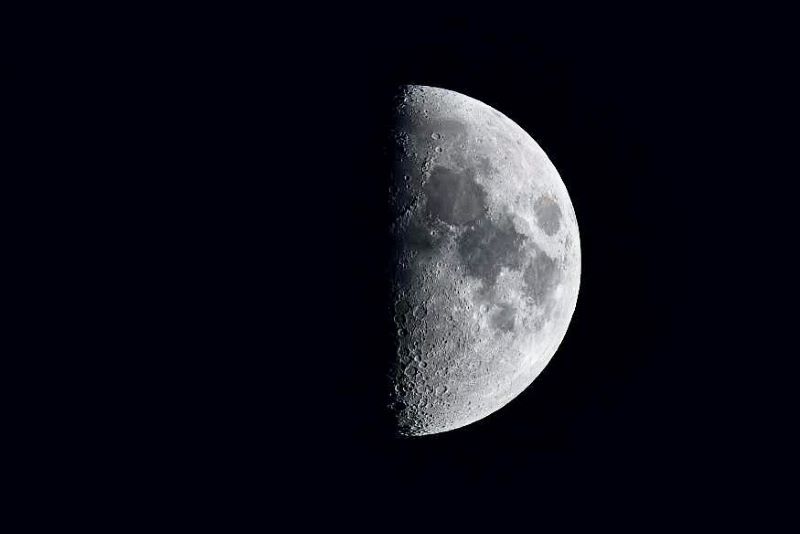Graham Jones of timeanddate.com joins with Deborah Byrd of EarthSky to explain why the December 4-5 quarter moon – aka a ‘half moon’ – is more than 50% illuminated. Plus, we share some key moon dates for 2024, from the closest moon to the shortest lunar month. Original article from timeanddate.com on November 27, 2023. Reprinted with permission. Edits by EarthSky.
Quarter moon or half moon?
From our perspective on Earth, the 3rd quarter moon on the night of December 4-5, 2023, will be the most-illuminated quarter moon of this year. It’ll be 50.137% lit, as seen by us on Earth.
A quarter moon looks half-illuminated in Earth’s sky. Some people even call it a half moon. And we in astronomy often say a quarter moon – aka a half moon – appears from Earth to be 50% illuminated.
But it’s not true. Instead, every quarter moon (half moon) is always slightly more than 50% illuminated.
And the December 4-5, 2023, quarter moon is the most illuminated of all the quarter moons this year.
A fraction more than half?
Who knew that a quarter moon is always more than half illuminated? That’s not common knowledge, even among astronomers. But it’s true.
Here’s why. In astronomy, we define the instant of quarter moon as when the sun and moon are separated by 90 degrees, as seen from Earth.
But, in order for the moon to appear exactly 50% illuminated for an observer on Earth, the sun and Earth must be separated by 90 degrees, from the perspective of the moon.
See? It’s a tiny difference, but a measurable one. From Earth, at every quarter moon, a fraction more than 50% of the Earth-facing side of the moon is illuminated.

Not to scale
The illustration above is a very rough representation of the triangle formed by the sun, Earth, and moon. In reality, the distance from Earth to the moon is about 30 times the diameter of Earth. The distance from Earth to the sun, meanwhile, is around 12,000 times Earth’s diameter.
In other words, although our not-to-scale illustration shows a small and compact triangle, the actual triangle is extremely long and narrow.
As the moon travels along its orbit, the moment when it is exactly 50% illuminated comes around 20 minutes after the moment of 3rd quarter, or before the moment of 1st quarter.
(Our illustration ignores an effect called parallax, where the moon’s position differs by a tiny amount depending on your observing location on Earth. Moon phase calculations are based on the centers of the Earth and moon.)
December 5 is also the farthest quarter moon
Although the 3rd quarter moon on December 5 won’t look different from any other quarter moon, it will also be the farthest quarter moon from Earth in 2023. This is not a complete coincidence: as the Earth-moon distance gets larger, the percentage of the moon’s face that is lit up increases.
Similarly, it is no coincidence that December 5 falls near perihelion (early January), when Earth is closest to the sun. A smaller Earth-sun distance also leads to a greater percentage of the moon’s face being lit up.

Lesser-known moon dates for 2024
The moon’s orbit around Earth is never the same from one lunar month to the next, leading to events such as supermoons and micromoons.
So, again, in 2023, the most-illuminated quarter moon will be the 3rd quarter moon of December 5. And, in 2024, the most-illuminated quarter moon will be the 3rd quarter moon of December 22.
Here are seven lesser-known lunar events for 2024.
January 25: Longest moon phase of 2024. There will be 8.225 days between full moon on January 25 and 3rd quarter moon on February 2.
March 10: Closest moon of 2024. The most extreme Earth-moon distances occur at new moon or full moon. At new moon on March 10, the moon will be 221,764 miles (356,895 km) away.
May 30: Shortest lunar month of 2024. The moon will cycle through all its phases – from 3rd quarter moon on May 30 to 3rd quarter moon on June 28 – in 29.195 days.
August 19: Shortest moon phase of 2024. The moon will take 6.625 days to wane from full moon on August 19 to 3rd quarter moon on August 26.
October 2: Farthest moon of 2024. At new moon on October 2, the distance to the moon will be 252,597 miles (406,516 km).
November 23: Longest lunar month of 2024. It will take the moon 29.868 days to go from 3rd quarter on November 23 to 3rd quarter on December 22.
December 22: Most-illuminated quarter moon of 2024. And so it comes around again!
Bottom line: Some quarter moons are fuller than others! The most-illuminated quarter moon of 2023 is on December 5. This happens when the moon is in a slightly different position in its orbit … a little bit after 3rd quarter, or a little bit before 1st quarter. Learn more unique moon dates for 2024.

